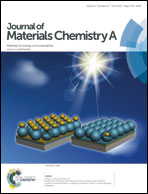Fabrication of core–shell structured mesoporous silica nanospheres with dually oriented mesochannels through pore engineering†
Abstract
This work focuses on engineering the pore orientations and pore sizes of mesoporous silica nanospheres (MSNs) in one pot. Core–shell structured MSNs possessing dual mesochannel orientation in one particle and tunable larger mesopores (3.0–7.3 nm) have been synthesized by using cetyltrimethyl ammonium bromide (CTAB) as a template with the aid of 1,3,5-trimethylbenzene (TMB). The formation of penetrating and radial mesochannels in the respective core and shell has been characterized by scanning electron microscopy, transmission electron microscopy, and N2 sorption techniques and has been further confirmed by the two-step adsorption and desorption curves for lysozymes. Moreover, the pore sizes, core sizes and shell thicknesses of dual-oriented MSNs can be easily tuned by varying the TMB content and the synthesis temperature. The mechanism investigations suggest that the initially formed silicate species with penetrating channels act as nuclei for the radial arrangement of cylindrical micelles for the formation of dually oriented mesostructures, in which TMB can control the pore orientation and pore diameter by affecting the kinetics of the solid silica formation and the swelling of the CTAB micelles.


 Please wait while we load your content...
Please wait while we load your content...